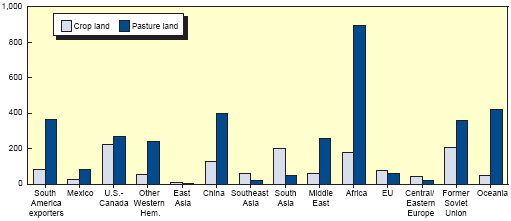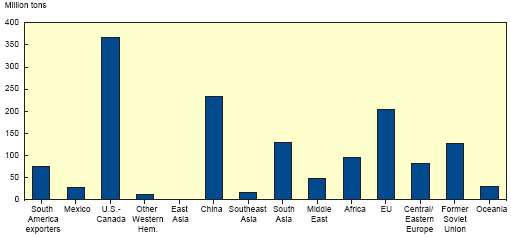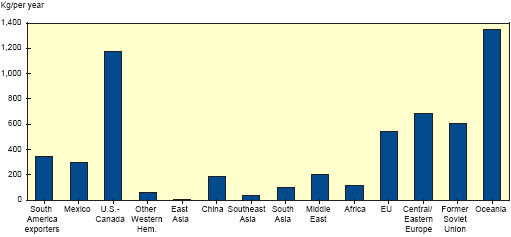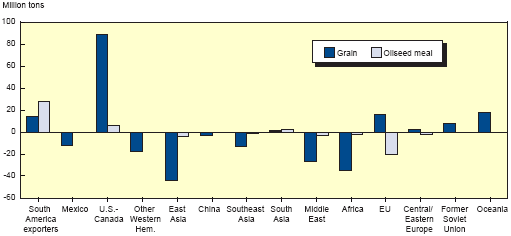



Appendix 1: Feeding Meat Animals - Where Are the Feed Resources?
By John H. Dyck and Kenneth E. Nelson. This is the seventh article in the series taken from the Economic Research Service's Structure of the Global Markets for Meat report. To read the other articles in this report, see the Further Sections table below.
To answer this question, it is important first to know where feed crops are produced and where pasture resources lie. Second, the extent to which the potential feed ingredients are used for animal feed or for competing uses such as direct human consumption — e.g., as wheat for flour use, corn for tortilla use, or soybeans for tofu—needs to be assessed. This is an issue even for pasture. While pasture cannot be used for human consumption, it is sometimes possible to convert pasture area into cropland, and crops can often be used for direct human consumption.
Feed production requires land. A large area for cropland or for pasture is one indicator of high potential feed production. Several parts of the world have large cropland bases (fig. A-1). In contrast, East Asia (Japan, Korea, and Taiwan) has a small cropland area. Pasture land is abundant in Africa, followed by Oceania, China, the former Soviet Union, South America, and North America (for the purpose of this report, defined as the United States and Canada). Comparatively little
pasture is available in East Asia, Southeast Asia, South Asia, and Europe.
Crop area is one determining factor for feed production, but feed production potential across the world’s regions also varies according to a region’s climate and land quality. Existing institutional and cultural arrangements also affect feed production. One indicator of current feed production potential is the total grain production (fig. A-2).1 This reflects the amount of land farmed as well as the current yields achieved on that land. North America is by far the largest grain producing region, followed by China and the European Union.
| Figure A-1: Crop and pasture land by region | ||
 |
||
| Source: FAOSTAT (data are the average for 1996 - 2000). | ||
| Figure A-2: Grain production, 1998-2002 average | ||
 |
||
| Source: USDA Production, Supply, and Distribution database. | ||
| Figure A-3: Grain production per person, 1998-2002 average | ||
 |
||
| Source: USDA Production, Supply, and Distribution database. | ||
| Figure A-4: Grain/meal surpluses and deficits: Production minus consumption, 1998-2002 average | ||
 |
||
| Source: USDA Production, Supply, and Distribution database. | ||
Where Are Current Deficits and Surpluses In Regional Feed Use?
The world’s 6 billion people are not distributed in the same way as the world’s resources for animal feed production. A region with a large population will need more grain for foodstuffs than a region with fewer people. Production can be divided by population to give an initial, indirect indication of how much grain is available for animal feeds. If grain production per person is high, there is likely to be grain left over after direct human consumption is satisfied. Figure A-3 shows that North America and Oceania produce over one ton of grain per person, and Europe produces about half that. These amounts are in excess of human food needs for grain (average cereal supply per person for food use was 156 kg per year, 1998-2000, according to the Food and Agriculture Organization), and indicate substantial grain availability for feed use or export. In contrast, much less grain (excluding rice) is produced per person in East Asia, Southeast Asia, Africa, and China. Even though rice is a principal food grain in these regions (which produce a great deal of rice, satisfying much of their foodgrain needs), wheat-based foods are still important, and the amount of grain produced per person is small relative to other regions.2
Data on overall deficits and surpluses in grain use provide another important indicator of regional feed deficits and surpluses. Direct measurement of feedgrain production within a region and of the ultimate use (for direct human consumption or for feed) of grain imports and exports is difficult and requires assumptions that raise the likelihood of error. Overall (with rice netted out), North America had a large surplus of grain (for all uses, on average, 1996-2000, see fig. A-4). Oceania, South America, Europe and the Former Soviet Union also had surpluses. East Asia, Africa, the Middle East, Southeast Asia, and Mexico had substantial deficits.
Oilseed meals are a second important ingredient of modern feed rations. Most oilseed meal is used for feed. Oilseeds can be consumed with or without being crushed. Oilseed crushing produces vegetable oil and oilseed meals, while uncrushed oilseeds are also used for a variety of foods. Oilseed meal production less oilseed meal use shows, on a regional basis, which regions currently have more meal than they can use, and which need to import. Figure A-4 shows that South America has a large surplus in oilseed meal. North America and South Asia (India is the only country with an oilseed meal surplus in South Asia) are also in surplus, while the rest of the world consumes more oilseed meal than it produces. Often, oilseed meal is produced by crushing oilseeds that are imported, rather than produced within a region. This is difficult to measure, but if the oilseed meal produced from imported oilseeds were added to direct oilseed meal imports, some of the deficit regions (especially East Asia, which imports virtually all its oilseeds for crushing) would show much greater deficits and North America would show a larger surplus.
Where Will Meat Production Increase To Supply Rising Future Demand?
Since feed costs are the largest component of the production cost for meat animals, regions that have abundant, low-cost feed available will have an advantage in animal production. Transport costs for grains and oilseed meals raise feed costs. The regional data show that parts of North and South America have considerable surpluses in grains and oilseed meals, the two largest components of feeds. In the future, this provides a solid, initial advantage for those regions in producing more animals in order to export more meat than they do now. Their current grain and meal exports could be replaced by meat exports. The EU, Oceania, and the former Soviet Union republics have large grain surpluses, but not surpluses of oilseed meals. The meal deficit is particularly large in the EU. Future use of grain to produce animals for meat export would be partially offset by a growing need to import oilseeds for crushing or oilseed meals, which would incorporate a transportation cost. Oceania’s grain exports are primarily wheat for food uses. Grain for food use is typically valued higher than feedgrains, so it is unlikely that Australia in the future would replace food-use grain exports with domestic use of the grain for feed. Russia, Ukraine, and Kazakhstan are economies in transition, and the degree to which they could produce more oilseed meal domestically is difficult to gauge. Grain yields and domestic infrastructure for agriculture in those countries have improved in recent years, and grain resources for potential meat exports may grow in the future.
East Asia has the largest deficit in grains of any region, as well as a deficit in oilseed meals. The oilseed meal deficit is actually greater, if the region’s near-total dependence on oilseed imports is taken into account. Imported oilseeds include transportation charges, which raise the cost of the meal and oil made from them. Greater meat production in East Asia would require even greater imports of grain and meal, at a cost in terms of transportation. Even maintaining current production is difficult, since higher feed costs burden the region’s meat production as it competes against imported meat from North America and Oceania. Africa, the Middle East, Southeast Asia, and Mexico all show significant deficits in non-rice grains as well as smaller deficits in oilseed meals. As in the case of East Asia, these facts indicate that greater meat production would incur transportation costs from importing grains and meals. In terms of domestic resources for intensive animal feeding with grains and meals, these regions do not appear well-positioned to generate meat exports. However, Africa and the Middle East each have a large endowment of pasture land. If that endowment could be made more productive or used more intensively, production of sheep and cattle meat from grass-fed animals might increase.
North and South America appear to be potential sources of greater meat exports, if their current surplus capacity in grains and meals are the only factors to consider. Each region, however, is vast in area. Even within these regions, resources and demand patterns can vary widely, and transport costs for feeds can be important. While for Brazil, Argentina, Paraguay, and Uruguay as a region there is a grain surplus over current consumption, the surplus exists entirely in Argentina, and Brazil had a grain deficit between 1996 and 2000. Growth in animal feeding in Brazil that involved importing grains from Argentina would add transport costs. In the United States, the Midwest has large surpluses of grain and meal, while current large meat-producing areas in the Southeast already depend in part on feedstuffs shipped in from the Midwest or from foreign sources.
Source: U.S. Department of Agriculture, Economic Research Service - September, 2003








